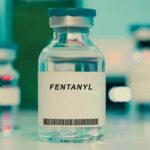- What Is Intranasal Fentanyl?
- Intranasal Fentanyl Effects
- Can You Overdose On Fentanyl Nasal Spray?
- What Else Can Treat Breakthrough Pain?
Intranasal fentanyl spray, also known by the brand name Lazanda, is an analgesic (pain reliever) used for breakthrough cancer pain. It is used only in people with severe pain who have a tolerance to opioids.
Lazanda can relieve pain but may also cause drowsiness, headache, and slow breathing. Similar to other opioids, Lazanda may also cause euphoric effects and has a high potential for abuse. Any form of fentanyl is dangerous and misusing it can lead to a life-threatening overdose.
What Is Intranasal Fentanyl?
Breakthrough pain is a brief increase in pain that can occur in people being treated for chronic or severe pain. Intranasal fentanyl is a liquid form of fentanyl citrate that can be effective in treating this type of acute pain.
Intranasal fentanyl enters the bloodstream quickly, similar to the effects of intravenous morphine, and can begin to relieve pain within minutes.
According to the Food and Drug Administration (FDA), intranasal fentanyl is administered in micrograms (mcg), ranging from 100 mcg to 800 mcg.
The first dose of fentanyl is one spray of 100 mcg in one nostril. The dose is adjusted as needed until it is strong enough to provide analgesia (pain relief) without causing serious adverse events.
Other Forms Of Fentanyl
Other forms of fentanyl include transdermal patches, lozenges, and intravenous fentanyl.
Patches are placed on the skin and deliver the drug through a time-release system. Lozenges deliver the drug orally, similar to the intranasal route, and can also treat breakthrough pain.
Intravenous fentanyl delivers the drug directly into the bloodstream, which is the most potent form of drug delivery.
Effects Of Intranasal Fentanyl
Intranasal fentanyl can be effective for acute pain because of its fast onset of action and high bioavailability. A high bioavailability means the body absorbs most of the drug and a lower dose may be sufficient to relieve pain.
After fentanyl is administered, it is absorbed through the nasal passages and binds to opioid receptors in the central nervous system. It works quickly but the effects are short-lived, which makes it beneficial for treating breakthrough pain.
Even if you are opioid tolerant, fentanyl nasal spray is a potent drug and may cause additional adverse effects, including:
- nasal irritation
- slow heart rate
- sedation
- headache
- hallucinations
- fever
- nausea/vomiting
- confusion
- hypotension (low blood pressure)
Can You Overdose On Fentanyl Nasal Spray?
Fentanyl nasal spray can be dangerous if it isn’t used as directed by a healthcare professional. Heavy use of intranasal fentanyl or mixing it with other opioids can cause respiratory depression, a condition that causes labored breathing.
Additional signs of opioid overdose include:
- bluish skin tone
- pinpoint pupils
- clammy skin
- unresponsiveness
- loss of consciousness
If you think someone may be overdosing, seek medical care immediately. If left untreated, an opioid overdose can lead to coma, brain damage, or death. After an overdose, emergency responders may transport the individual to a hospital to monitor vital signs until stabilized.
What Else Can Treat Breakthrough Pain?
Opioids are the most common form of treatment for breakthrough pain because this type of pain can be severe. However, other types of drugs are being studied for their effectiveness in treating acute pain.
A randomized controlled trial of pediatric patients compared intranasal fentanyl and intranasal ketamine, an anesthetic, for the treatment of acute pain. The children involved in the clinical trial were emergency department patients with severe injuries.
The study found that ketamine caused some mild side effects but was comparable to fentanyl for treating acute pain. Although ketamine use can lead to dependence, it may not be as severe as opioid addiction.
Opioid Addiction
Similar to other opioids, like oxycodone and hydrocodone, fentanyl has a high risk of dependence and addiction. Addiction can lead to compulsive drug use and uncontrollable cravings that make it difficult to stop using opioids without professional help.
At Northeast Addictions Treatment Center, we can help you overcome drug addiction with a personalized treatment plan. Our evidence-based treatment options include behavioral therapy, 12-step facilitation, and family therapy in a supportive outpatient setting.
To learn more about our addiction treatment programs, please contact us today to speak with a specialist.
Sources
- Food And Drug Administration (FDA) — Lazanda
- Jama Pediatrics — Effect Of Intranasal Ketamine Vs Fentanyl On Pain Reduction For Extremity Injuries In Children
- National Library of Medicine: MedlinePlus — Fentanyl Nasal Spray
- National Library Of Medicine: PubMed — Fentanyl Nasal Spray For The Treatment Of Cancer Pain
Written by
Northeast Addition Editorial Team
©2024 Northeast Addition Center | All Rights Reserved
This page does not provide medical advice.


